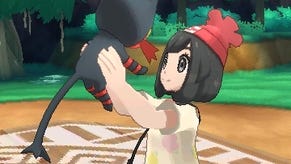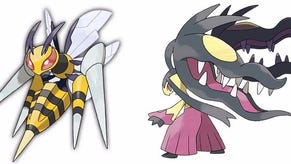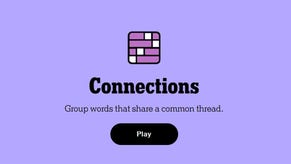Pokémon Sun and Moon breeding - how to breed 6IV Pokémon and pass on Abilities, Natures, Egg Moves, and Poké Balls in Ultra Sun and Ultra Moon
How to breed your way to a competition-ready Pokémon.
Breeding Pokémon is one of the most important, and complex, skills you can learn for the Pokémon Sun and Moon and Ultra Sun and Ultra Moon metagame.
In fact it's really a skill that will serve you well for, we'd imagine, plenty of mainline Pokémon games in the future, as in recent years it's become a central mechanic for gaining a variety of pretty huge benefits, from flawless stats to exclusive Egg Moves and your choice of the optimal Abilities and Natures.
With that in mind, here on this page we'll take you through everything you need to know about breeding in Pokémon Sun and Moon, including the fastest breeding method for 6IV Pokémon, how to get 4IV Dittos for speeding things up, and how to pass on Egg Moves, Abilities, Natures, and even Poké Balls from one Pokémon to the next.
For more on competitive Pokémon meanwhile, head back to our main Sun and Moon competitive training guide, or take a look at our pages on IVs and base stats explained, EVs and EV training locations, and our explainer on the Hyper Training and best way to farm Bottle Caps.
Note that, as of Pokémon Ultra Sun and Ultra Moon's release, we're still updating this page to double check all of the below methods work. In theory though they're all the same - so don't expect many changes!
Pokémon Sun and Moon breeding explained - breeding rules, how to breed Pokémon, and the Pokémon Ranch in Ultra Sun and Ultra Moon
Before we really get stuck into the step-by-step process of breeding Pokémon in Sun and Moon, for whatever purpose that may be, it's probably wise to make note of how the rules and mechanics of breeding actually work, plus a quick runthrough of why exactly you may want to breed Pokémon.
Firstly, the most basic point of breeding is that it allows you access to the base evolution of a Pokémon at level 1. Pokémon hatched from Eggs that you've bred are essentially blank slates, with everything from their base stats and IVs, to their Nature, Ability, Poké Ball and more being influencable through the breeding process. They'll also have a completely blank set of EVs, too, and a moveset that you have the ability to control. Basically, breeding gives you the utmost control over the specifics of the Pokémon of your choice.
Up until this most recent generation of games, in fact, breeding was the only way to manipulate a Pokémon's IVs. Now, of course, there's Hyper Training, and a particularly good Bottle Cap farming and Hyper Training method we've detailed separately. But nonetheless there are still a huge number of reasons to breed. Below, we'll be taking you through an explanation of them all.
Alright, let's dive in to some more of the rules and basics!
How to breed Pokémon in Sun and Moon - Pokémon Ranch
Breeding in Pokémon Sun and Moon is similar, if not identical, to the way things worked in previous Pokémon generations. First up, you'll need to take two compatible Pokémon to Paniola Ranch, just north of Paniola Town. Then, if they're compatible, they will produce a Pokémon Egg after you've taken certain number of steps in-game. At that point however, there are a few things to bear in mind:
- Any Pokémon that is capable of breeding at all is also able to breed with a Ditto.
- Two Pokémon that are capable of breeding don't need to be of the same species, just the same Egg Group. An Alakazam can breed with a Machamp, for example, because they both belong to the 'Human-like' Egg Group.
- If neither Pokémon is a Ditto, then they must be two opposing genders. A female Alakazam and a male Machamp, for example.
- The amount of steps required for the two Pokémon to produce an eggs varies depending on the Pokémon you've chosen.
- In Sun and Moon, Pokémon placed in the Ranch no long level-up over time, its sole purpose now is breeding. Nice.
How to pass down Abilities, Natures, and Poké Balls through Breeding in Pokémon Sun and Moon and Ultra Sun and Ultra Moon
Moving on one step in complexity from the absolute basics, it's time to start talking about the specific rules and mechanics, starting with Abilities, Natures, and Poké Balls:
How to pass down Abilities by breeding in Pokémon Sun and Moon
Abilities are passed down in Sun and Moon by chance, but there is at least something you can do to affect it. There is an 80 per cent chance that the Ability passed down will be that of the female parent, which also goes for Hidden Abilities, too.
How to pass down Natures by breeding in Pokémon Sun and Moon
Without any special held items, a hatched Pokémon's Nature is generated at random.
There is, however, a way to modify that - give a parent Pokémon an Everstone, and that parent's Nature is guaranteed to pass down to the hatched Pokémon. Note however that if both parents are holding an Everstone, and they have two different Natures, it's a 50-50 chance for which Nature is passed down.
How to pass down Poké Balls by breeding in Pokémon Sun and Moon
Finally, Poké Balls can be passed on through breeding, normally according to the rule that the female parent always passes on their Poké Ball.
Note, however, that if a male Pokémon is bred with a Ditto, that male Pokémon will pass on their Poké Ball, so with the right planning it's possible to chain-breed Poké Balls on from males, too.
Pokémon Sun and Moon - how to pass down IVs, stats, and Egg Moves through breeding in Pokémon Ultra Sun and Ultra Moon
Finally, it's time for arguably the most important aspects of breeding for competitively viable Pokémon that you can put to use in the Battle Tree, Battle Royal, or online competitions:
How to pass down IVs by breeding in Pokémon Sun and Moon
Broadly speaking, IVs - in other words, the hidden numbers which dictate the strenght of a Pokémon's base stats - are passed on in a number of ways:
- Destiny Knot - the best way to pass on multiple IVs quickly. Give either parent Pokémon the Destiny Knot to hold whilst in the Ranch, and a total of five IVs, taken at random from the IVs of the two parents, will be passed on to the hatched Pokémon.
- Power Items - giving a parent Pokémon a Power Item to hold will pass on the IVs for that specific stat to the hatched Pokémon. The Power Weight, Power Bracer, Power Belt, Power Lens, Power Band, and Power Anklet pass on IVs for HP, Attack, Defense, Special Attack, Special Defense, and Speed respectively. You could give one Pokémon a Power Item and the other a Destiny Knot, but there would still only be five IVs passed down, the Power Item just guarantees one of them.
- No Items - Without any special items, a total three IVs will be passed down from the two parents, selected at random. The hatched Pokémon's other three IVs are completely random.
For more on Pokémon Ultra Sun and Moon, head to our main Pokémon Ultra Sun and Ultra Moon walkthrough and guide hub, which includes guides to new Ultra Sun and Ultra Moon Pokémon and Pokédex changes, the Festival Plaza, a list of Global Missions and rewards, an explainer on Pokémon Bank, a dedicated page on Pokémon Competitive Training, including IV Training, EVs and hidden stats, Breeding 6IV Pokémon explained and how to farm Bottle Caps fast for Hyper Training. What's more, we have pages on the Rockruff event for getting Dusk Form Lycanroc and, last but not least, a full Ultra Sun and Ultra Moon QR codes list for adding all Pokémon to your Pokédex.
This, however, isn't the full story. If you want to really breed a Pokémon from scratch, and cover every single aspect in one long chain of steps, it's going to take a very long time. But there is a shortcut! As of Sun and Moon, IVs are no longer completely fixed after a Pokémon is hatched.
Thanks to the addition of Hyper Training, and one particularly smart means of farming the required Bottle Caps for it, players can now essentially max out a Pokémon's IVs to their highest potential without having to perform the standard, lengthy process of breeding for the perfect stats. We talk you through Hyper Training and the fastest way to farm Bottle Caps over in our dedicated guide.
The downside to the Hyper Training route? Well, it requires your Pokémon to have reached level 100 before you can perform it. So while it's great for competitive players who'll likely want level 100 Pokémon anyway, it's no use at all if you want a stat-perfect Pokémon for a standard playthrough.
If that's what you're after, we recommend you check out this excellent walkthrough from the community, written up by user Xicarda on Pastebin. Fair warning though: it's extremely long-winded, but will absolutely save you a huge amount of time when it comes to breeding if you want to do it the long way. In brief, the steps involve:
- Acquiring all the basic items and facilities required - you'll need a Destiny Knot, an Everstone, and the IV judge function for your PC.
- SOS chaining wild Ditto until you have two, both with four perfect sets of IVs, covering all six stats between them - you'll need a good Pokémon with False Swipe, decent Attack and Speed stats, and potentially other utility Pokémon like Munchlax to stop the chained Ditto from knocking itself out.
- Catching a Ditto with each of the most useful Natures - Timid, Modest, Adamant, Bold, Careful, Jolly, and Impish are generally the ones used in competitive play.
- Breeding a Pokémon with the right Nature - using one of the Nature Dittos you just caught.
- Breeding that Pokémon with one 4IV Ditto - using the Everstone and Destiny Knot to pass on Natures and five random IVs, until that Pokémon has IVs that are at least as good as one of your two 4IV Dittos.
- Breeding that Pokémon with the other 4IV Ditto - so you eventually get a Pokémon with the other 4IVs covered.
- Breeding those two non-Ditto, four-or-five-IV Pokémon together - until, eventually, you get a Pokémon with the full, perfect, 6IV spread of stats and the right nature!
As we said, it's a long process, and we highly recommend using the Hyper Training and Bottle Cap farming method wherever possible, or giving that guide from Xicarda, linked above, a good look if you need to do it the long way!
How to pass down Egg Moves in Pokémon Sun and Moon
Egg Moves are moves that a Pokémon can only learn through breeding that one of the more complex aspects of breeding - IVs aside - often requiring long chains for them to be passed down. Here are the key points:
- Egg moves pass on from either the mother or the father now, but the Pokémon species always passes on from the mother.
- So, to get an egg move onto a Pokémon that wouldn't normally be able to learn it, you want to breed it with another Pokémon from a different species - but the same egg group - that can learn it.
- E.g. Abra and Machop, both in the 'Human-like' Egg Group. Machop learns Knock Off at Level 21, and Abra can learn this as an Egg Move only.
- Breed a Male Machop with Knock Off with a female Abra, and the resulting Pokémon hatched from the Egg will be an either male or female Abra, with Knock Off.
- Longer chains are possible, the following example shows how you can get moves onto Pokémon from across Egg Groups:
- Ampharos, of the 'Field' egg group, can learn Thunder Punch by levelling up
- Breed a male Ampharos with a female Buneary (which is both 'Field' and 'Human-like' Egg Groups), until you hatch a male Buneary with Thunder Punch
- Breed the male Buneary with a female Machop (Human-like Egg Group), and the newly-hatched Machop will get Thunder Punch!

















